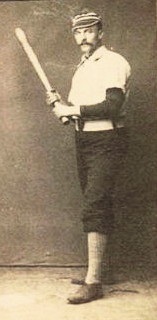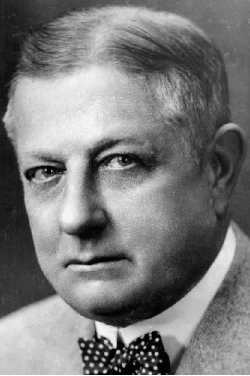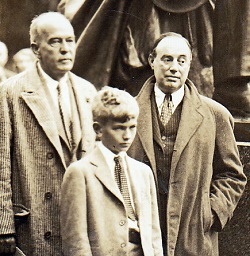Cooperstown "The Home of Baseball"

In the spring of 1919, four old-time baseball players were sitting around a hot stove in Michael Fogarty's smoke shop in Llion, New York, discussing the Village of Cooperstown as the birthplace of baseball. Hardie Richardson, George Oliver, George White and Patrick Fitzpatrick observed that Cooperstown didn't have a ball field. They decided to start a fund to build one. The group wrote to Samuel "Sam" Crane, a former ballplayer and journeyman sportswriter for the New York Journal. He agreed to write an article about the birthplace of baseball. Crane wrote several articles about Cooperstown and the need for a ball field. His articles were well received by the Village and Major League baseball. So much so, that New York Giants owner Harry Hempstead and recently resigned National League president John K. Tener visited Cooperstown and suggested that John Heydler, new president of the National League, might also be interested in the story. Heydler visited Cooperstown and became one of the best advocates for the creation of a ball field dedicated to Abner Doubleday. His passion cannot be understated. He was impressed with the community and felt it was the perfect place to serve as the birthplace of baseball. This outside interest ignited the enthusiasm of the Cooperstown Rotary Club and the Chamber of Commerce. Those groups set about to purchase or lease Alexander Phinney's pasture and create a public playground. With the help of the First National Bank of Cooperstown, Dr. Ernest Pitcher was the first major financial contributor to securing the property.
With the lease of the property secured, fund-raising began in order to make permanent a ball field for the Village of Cooperstown. The Rotary Club and the Chamber of Commerce worked diligently to secure more funds to complete the project. The community came together to bring to reality Doubleday Field. Heydlers continued support created a buzz within Major League Baseball. His support, both personally and financially, helped to solidify the importance of a shrine marking baseball's birthplace.

The ballfield was completed on September 6, 1920, and John Heydler, serving as umpire, officiated the first game. The Village celebrated the conclusion of the project with a street fair to raise additional funds and support for Cooperstown's newest asset, Doubleday Field. Many in the community were unsatisfied with the condition of the new ballpark and improvements were suggested by the Chamber of Commerce. John Heydler suggested contacting John McGraw of the New York Giants for support and suggestions for upgrades to the playing field. McGraw called on his friend Henry Fabian, groundskeeper of the New York Giants and a former teammate in the minor leagues in Cedar Rapids. Mr. Fabian was a gifted horticulturist and made several recommendations that would require the purchase of additional lands necessary to extend the ball field to Major League proportions. The Chamber of Commerce endorsed Fabian's recommendations and communicated them to the Village fathers. All agreed it would be in the best interest of Cooperstown to make the necessary improvements. The lease of the property was coming due for renewal and the property owner preferred to sell as opposed to extending the lease. The community agree to purchase the property and the adjacent land would also be acquired.
John Heydler suggested that Ford Frick, the new president of the National League, take a serious interest in the project in Cooperstown. Frick agree it was in the best interest of Major League Baseball to continue to support the project and suggested that funding for this public property may be achieved with the help of the WPA. The Village fathers made application to the WPA. Their application was approved. As a result, the scope of the project substantially changed and the direct beneficiary was the Village of Cooperstown. The Chamber of Commerce became more active along with the Rotary Club and the Masonic Temple to pursue this expanded project as a major asset for the business community. Many Village meetings were held to meet the demands of the project and a special committee was established to coordinate fund-raising activities and construction. In 1923, a series of Village meetings look place to appropriate the funds to purchase the property which was officially transferred to the community in 1926. The property was expanded to the dimensions that were earlier suggested and a more fitting ball field was created and used for a number of years. Many subtle changes occurred between 1926 and 1934. As more ideas were adopted, additional funds were required. The project was never really concluded and under other circumstances the Village may have given up. However, the Village was dedicated to the project and took these changes and need for additional funding in stride.

Alaxender Cleland & Stephen Clark Jr
National interest in the birthplace of baseball continued to grow including the idea of building a museum to celebrate baseball and display a collection of baseball artifacts. The Village was committed to supporting the new ideas with fund-raising activities to meet the requirements. The Clark family, prominent in the community, saw the value of establishing a museum. Stephen Clark a well-known philanthropist and a major supporter of the New York State Historical Association, committed to financing this phase of the project. His administrative assistant, Alexander Cleland, was given the responsibility of developing specifications for a baseball museum. Cleland developed drawings and estimated costs for construction at $100,000. The Clark Foundation supported this plan and committed to see its construction.
Once again, the community was faced with a fund-raising need. To coordinate the multiple projects being considered by the community, a central oversight committee was created to manage the multiple projects and develop a single fund-raising theme. The Village of Cooperstown had several standing committees to manage the various projects. the most prominent of which was the Doubleday Field Association, charged with coordinating most of the fund-raising through 1934. In the winter of 1934, Stephen Clark was able to purchase a baseball for five dollars that was supposedly owned by Abner Graves and found at Fly Creek. This was the first donation to the proposed museum and solidified the Graves-Doubleday connection.
